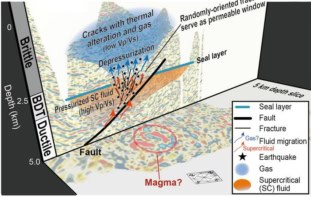Physicists have reproduced the fluid dynamo mechanism that produces the Earth's magnetic field in a laboratory experiment for the first time. Electric currents produced by the circulation of the molten iron and nickel that surround the Earth's core are thought to create the Earth's magnetic field. Now physicists from Latvia and Germany have measured magnetic fields produced in liquid metal in a special facility at Riga, Latvia. The fields match the predictions of fluid dynamo theory (Phys Rev. Lett. 84 4365).
A conducting fluid needs to have a small ‘seed’ magnetic field before it can generate a self- sustaining field. The seed field induces electric currents in the fluid that in turn create a more powerful, and stable, magnetic field. This creation of the field relies on a positive feedback mechanism. However, the process only works if the metallic fluid is moving very quickly or if it exists in very large quantities.
The Latvian-German team applied a small magnetic field to a container filled with two cubic metres of molten sodium that was rotating at 15 metres per second. The high conductivity and velocity of liquid sodium was fast enough to generate an oscillating magnetic field in the fluid, and this field was maintained when the external magnetic field was turned off.



